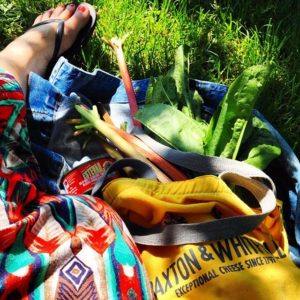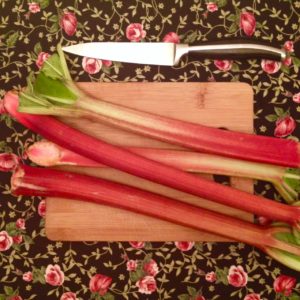Summer markets and sour spring things
 This summer we’re thrilled to have Emily Wight, author of well fed, flat broke (and popular blog of the same name) do a monthly guest post for our Market News blog!
This summer we’re thrilled to have Emily Wight, author of well fed, flat broke (and popular blog of the same name) do a monthly guest post for our Market News blog!
Emily has a knack for creating imaginative, nutritious, and delectable meals without breaking the bank; each month, she’s going to share her passion with the VFM community to help you stretch your dollar a little further while still incorporating the freshest, finest quality produce you can find in the city.
Look out for her posts in the 2nd week of the month – featuring savvy tips on budget shopping at the markets, easy recipes, nutritional information, and more! Read on for her May blog post…
Summer markets and sour spring things
By: Emily Wight
 With the Trout Lake market now underway, spring has officially sprung. We wandered over on Saturday morning, and soon found coffees and PureBread and more bundles of crisp, luscious greens than I could have fit into my single shopping bag, but which I wanted nonetheless. I settled on a bunch of sorrel, and we wandered.
With the Trout Lake market now underway, spring has officially sprung. We wandered over on Saturday morning, and soon found coffees and PureBread and more bundles of crisp, luscious greens than I could have fit into my single shopping bag, but which I wanted nonetheless. I settled on a bunch of sorrel, and we wandered.
I never buy as much as I want to at the market (I walk there, with a four-year-old … which means I’m often carrying a four-year-old), but I do approach each visit as if on a kind of scavenger hunt. I’m working on some new recipes, so I picked up a few items for those – a litre of apple cider, a pound or two of rhubarb. I decided on a budget of $20, which would allow for one or two items to feature in dinners during the week, something fun, and something I might have otherwise bought in a supermarket, and something special.
 I don’t know if it’s just been too long since I’d been to Trout Lake, but I was thrilled to find so many fresh, wonderful things – sour little plums to be made into umeboshi, crisp mustard greens to find their home in saag paneer, delicate bunches of purslane and watercress for salads, cream cheese sandwiches, or green soups.
I don’t know if it’s just been too long since I’d been to Trout Lake, but I was thrilled to find so many fresh, wonderful things – sour little plums to be made into umeboshi, crisp mustard greens to find their home in saag paneer, delicate bunches of purslane and watercress for salads, cream cheese sandwiches, or green soups.
I settled on sorrel, which is a green I can usually only get at the Farmers Market – it’s an intensely flavourful perennial herb with large leaves and a bright, lemony taste. You can eat it raw or cooked. It’s high in oaxalic acid, so if you’re a bit sensitive, cooking will mellow the acidity a bit; I served it gently wilted in a bit of garlic butter, sprinkled with dried chilies and topped with crumbled Estevan line-caught tuna and a poached egg. If you can find sorrel this weekend, pick up a bunch! And lest you not know what to do with it, here are 50 things to do with fresh sorrel.
Taves Family Farms was at the market with gorgeous tomatoes, bell peppers, and herbs, but I love their apple cider so I grabbed a litre to reduce into applestroop, a Dutch syrup made from a reduction of apple cider and brown sugar. It’ll go on pancakes until it gets too hot to eat pancakes.
 And I grabbed rhubarb, which is a highly underrated thing that tastes best right this very moment. You can use rhubarb in sweet and savoury dishes – this salad from Yotam Ottolenghi is one of my favourite things to serve lunch guests right now – but I like it roasted in a bit of butter and sugar, with a bit of hangop.
And I grabbed rhubarb, which is a highly underrated thing that tastes best right this very moment. You can use rhubarb in sweet and savoury dishes – this salad from Yotam Ottolenghi is one of my favourite things to serve lunch guests right now – but I like it roasted in a bit of butter and sugar, with a bit of hangop.
Hangop with roasted rhubarb
Hangop is a Dutch dish made from strained yogurt; you can serve it plain, topped with fresh fruit, but I like to whisk a bit of orange juice and honey into it – it is equally good as a decadent breakfast or a low-key dessert. Choose a yogurt that’s at least 2 per cent milk fat, and that doesn’t contain any thickeners or stabilizers (I like Fraser Meadow yogurt, which comes from Agassiz and contains only milk and bacteria cultures).
(Makes four servings.)
Hangop
- 3 cups (750 mL) plain yogurt
- 1 large navel orange
- 2 tbsp. honey
- 1 vanilla bean, scraped or 1 tsp. pure vanilla extract
Line a fine-mesh sieve with cheesecloth, a clean dish towel, or paper towel, and position the sieve over a medium bowl. Let drain for eight hours, or overnight. The yogurt will thicken to a fresh cheese-like texture, and the whey will remain in the bowl; do not discard the whey – it’s a good source of protein, and you can add it to smoothies, soups or baked goods.
Scrape the strained yogurt into another bowl. Using a microplane or the small teeth on your cheese grater, zest the entire orange. Add this zest to the yogurt. Squeeze the juice of the orange into a small glass; measure three tablespoons of juice into the yogurt, and reserve the remaining juice for another use.
Add the honey, and the vanilla, and whisk the mixture together until smooth. Hangop can be made up to 48 hours in advance – store in a sealed container, in the refrigerator.
Roasted rhubarb
- 1 lb. (250 g) fresh rhubarb, trimmed
- 1 tbsp. butter, melted
- 1/3 cup (75 g) granulated sugar
Preheat your oven to 400°F (200°C).
Cut rhubarb into two-inch pieces. Place these into a small casserole or other baking dish, then add the butter and sugar and toss to coat.
Roast, uncovered, for 15 to 20 minutes, until the liquid is bubbling up around the rhubarb and the rhubarb is tender.
Let cool to room temperature.
Spoon dollops of hangop into bowls, then top with cooled rhubarb; drizzle lightly with the rhubarb juice from the baking dish.




